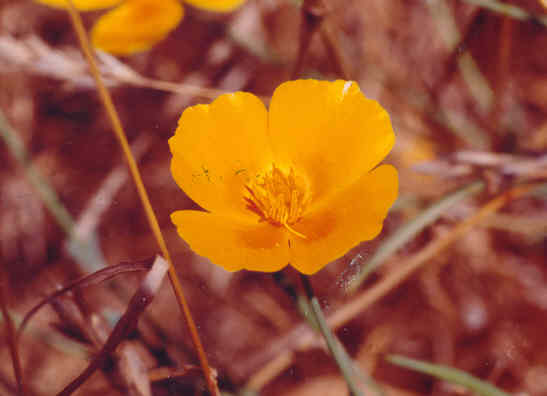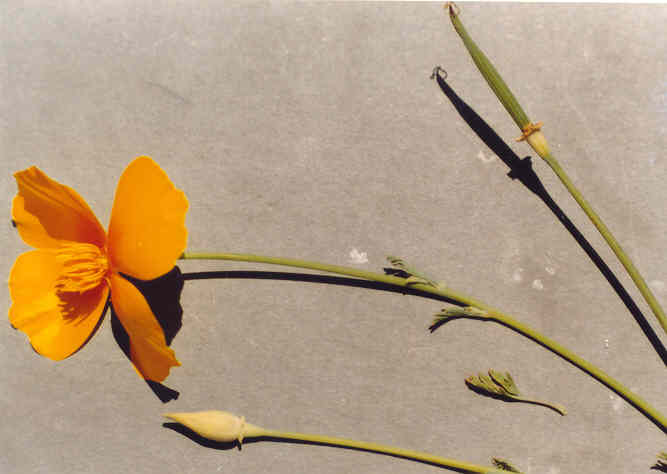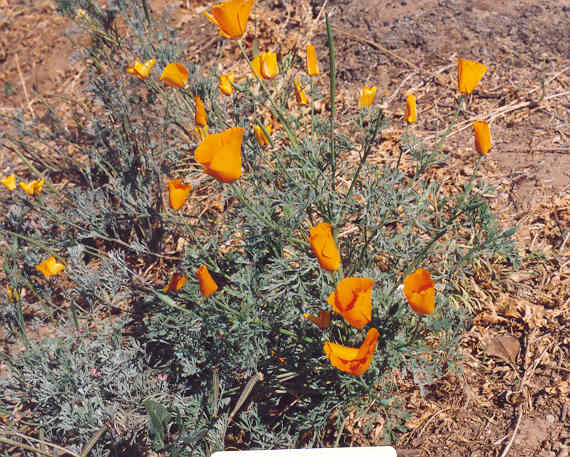
Eschscholzia californica Cham.
=Eschscholzia californica var. peninsularis
 |
Eschscholzia californica Cham.=Eschscholzia californica var. peninsularis
Papaveraceae (Poppy Family)NativeCalifornia Poppy |
July Photo
Plant Characteristics:
Annual to perennial, flowering the first year, freely branched, +/- glaucous,
generally nearly glabrous, the stems becoming 2-6 dm. long and falling over in
age; lvs. ternately several times dissected into narrow segments, the blades 2-6
cm. long, the basal lvs. petioled;
peduncles 3-15 cm. long; torus with 2 rims, the inner erect and hyaline, the
outer spreading and 2-4 mm. wide; calyptra 1-4 cm. long, variable in shape;
petals deep orange to light yellow, 2-6 cm. long; caps. 3-8 (-10) cm. long;
seeds gray-brown, round-oblong, 1.2-1.5 mm. long, reticulate with ca. 8-10
meshes per row.
Habitat:
Common in grassy and open places, after burns, etc., up to 6500 ft., many
Plant Communities; most of cismontane Calif. and w. part of Mojave Desert; to
Arizona. Feb.-Sept.
Name:
Named for J.F. Eschscholtz,
1793-1831, surgeon and naturalist with Russian expeditions to Pacific Coast in
1816 and 1824. (Munz, Flora So. Calif. 626). Californica
indicates that the plant was first found in this state.
(Dale 13).
General:
Occasional in the study area.
Photographed on the bluffs at the north end of Eastbluff.
(my comments). At maturity, the seed
vessel opens with an almost audible pop and throws the seed some distance.
The Spanish Californians call the poppy Dormidera, "the drowsy one", because the petals fold at
evening. They made a hair dressing
that they thought made the hair grow and shine by frying the blossoms in olive
oil and adding perfume. (Dale 148).
Indians used the leaves for toothache.
(Murphy 45). Indians ate the seeds either boiled
or roasted with hot stones. (Powers
425). The
California state flower. (Robbins
et al. 198).
With the addition of alum, the Calif. Poppy will produce a bright yellow
dye. (lecture by Charlotte Clarke,
author of Edible and Useful Plants of California, April 1987.
The Indians of Placer County, it is said, boil the herbage or roast it by
means of hot stones, lay it in water afterward and then eat it as greens.
A drug made from this plant is used in medicine as a harmless substitute
for morphine and as a remedy for headache and insomnia, and it has an especially
excellent effect with children. In
the early days when Spanish vessels sailed up and down the newly discovered
coast, the mariners, looking inland, saw the flame of the poppies upon the hills
and called this "the land of fire."
they said that the alter-cloth of San Pascual was spread upon the hills,
and filled with devotional spirit, they disembarked to worship upon the shore.
(Parsons 118).
The Cahuilla Indians, inhabitants of the Colorado Desert, the San
Bernardino and San Jacinto Mountains, used the plant as a sedative for babies.
The women used the pollen as a facial cosmetic.
(Bean & Saubel l73).
The Oakland-Berkeley Hills fire of October 20, 1991 destroyed many homes
and a number of lives were lost. Immediately
after the fire there was a debate at to what plants should be used to revegetate
the area. Following
are excerpts
from an article on the subject. (my comments).
“We understand that decisions were made under pressure and with short
time horizons. Over a ton of seeds
of a mixture recommended by the Soil Conservation Service was broadcast from a
helicopter or much or all of the burn following a heavy rain the previous
weekend. Of the six species in the
mixture, three are not native. These
are Festuca megalura, Trifolium hirtum
and Bromus mollis.
Of these, the brome and fescue are likely to be aggressive invaders,
while the clover, on the other hand, is likely to germinate and survive for a
generation or so, but it is unlikely to persist.
The three native species are Eschscholzia
californica, Lupinus ssp. and Elymus
glaucus. The poppy seed was from "somewhere in Oregon." This
species has great regional variation, so something new and different has
probably been massively added to the Oakland-Berkeley Hills.
The blue lupine, identified only to genus and flower color, was collected
from somewhere near Lompoc. The rye
was collected from "a few" plants in the Oakland-Berkeley Hills and
then grown to commercial quantities near Rio Vista.
Two questions come to mind at this point. Could or should the decision-makers have been better informed
as to the consequences of introducing non-local populations of native species?
Could they have been supplied with appropriate truly-native (locally
evolved) seeds on short notice? The
answers are probably yes and no respectively.
One alternative to emergency reseeding was to allow the resident native
and naturalized populations on the area to reclaim it.
We have not sufficient long-term experience with the seed mixture
broadcast onto the Oakland-Berkeley burn to know whether later deep instability
of the soil is increased as a result of such competitive exclusion or reduction
of deep rooted woody plants could be caused by members of the mixture.
It does seem that the use of Trifolium
hirtum would be a gentle
attempt to reduce mid-to-late first year surface erosion and gullying, while
allowing the resident ecosystem to re-establish itself without genetically
contaminating it. In addition to
the seeds sown from the helicopter, straw and straw bales were used to combat
erosion and mud slides. These were
oat straw (mostly Avena barbata and A. fatua, both naturalized) plus possibly some Eschscholzia californica var.
peninsularis, domesticated barley and wheat straw, plus seed-bearing field weeds. A more appropriate kind of straw for erosion would have been
rice straw, since its contaminating weed seeds are mostly from aquatic
environments, and they would not generally survive in the Oakland Hills.
There is an unusual situation, in that the upper northern edge of the
Oakland-Berkeley Hills burn is only about 1300 feet from the University of
California's Ecological Study Area in Claremont Canyon.
This area contains and provides opportunities for long-term studies of
evolving ecosystems. It is possible
that some seeds from the helicopter blew into the Ecological Study Area.
In future years, genetically contaminated offspring of the poppies and
perhaps of some lupines may migrate into the UC Ecological Study Area and some
of the studies may be invalidated by this introduction of genetically
contaminated native species”. (Libby, William J. and Rodrigues, Kimberly A.,
"Revegetating The 1991 Oakland-Berkeley Hills Burn", FREMONTIA, A
Journal of the California Native Plant Society, Jan. 1992, pp. 12-18). Like so many of the
family, a mild sedative and analgesic, suitable even for children.
A rounded teaspoon of the chopped plant as tea.
Excess quantities can cause a slight residual hangover the next morning.
(Moore, Medicinal Plants of the Mountain West 50).
Blister beetles, Lytta sp., will eat the California poppy flower, a plant that few
insects can tolerate as a food source. (Ross, Edward S., "Insect/Plant
Relationships: A Photographic Essay", FREMONTIA, A Journal of the
California Native Plant Society, April 1996 pp. 3-22).
Exceedingly variable with over 50 spp. proposed for the state.
(Munz, Flora So. Calif. 627).
Highly variable with more than 90 taxa described.
Annual plants with entire cotlyledons from the desert mountains have been
described as ssp. mexicana; large
plants from the southern Sierra Nevada Foothills have been called E. procera, the Kernville poppy.
Toxic but rarely eaten. (Hickman,
Ed. 814).
Text Ref:
Hickman, Ed. 813; Munz, Calif.
Flora 198; Munz, Flora So. Calif.
627.
Photo Ref:
July 2 83 # 24, E; April 2 84 # 10.
Identity: by R. De Ruff.
First Found: July 1983.
Computer Ref: Plant Data 239.
Have plant specimen.
Last edit 7/21/04.
 |
 |
July Photo June Photo